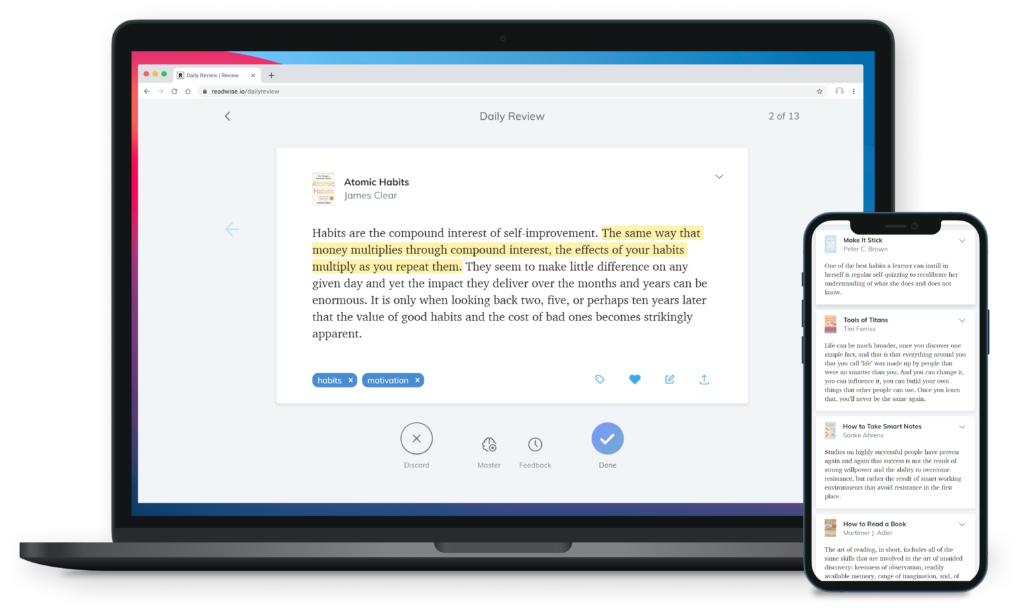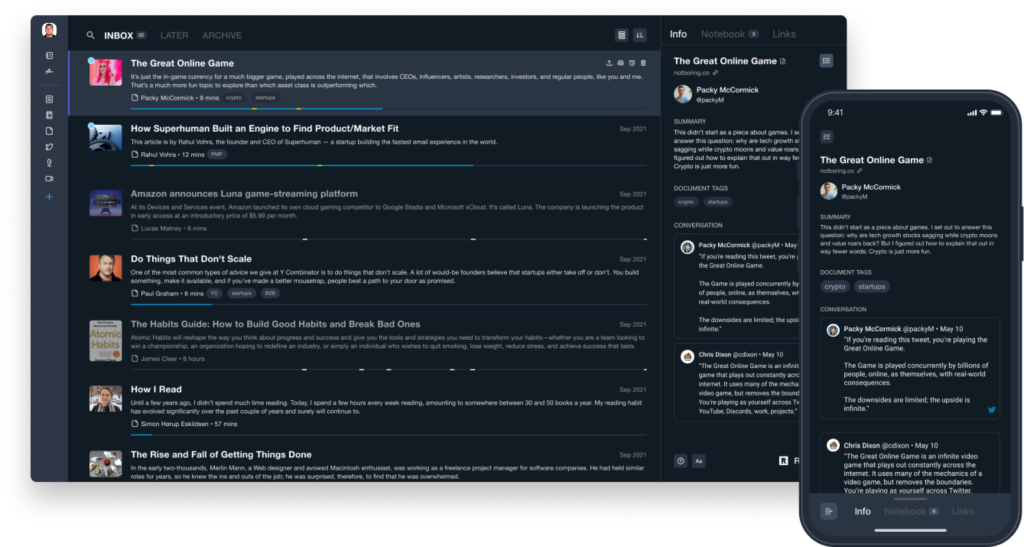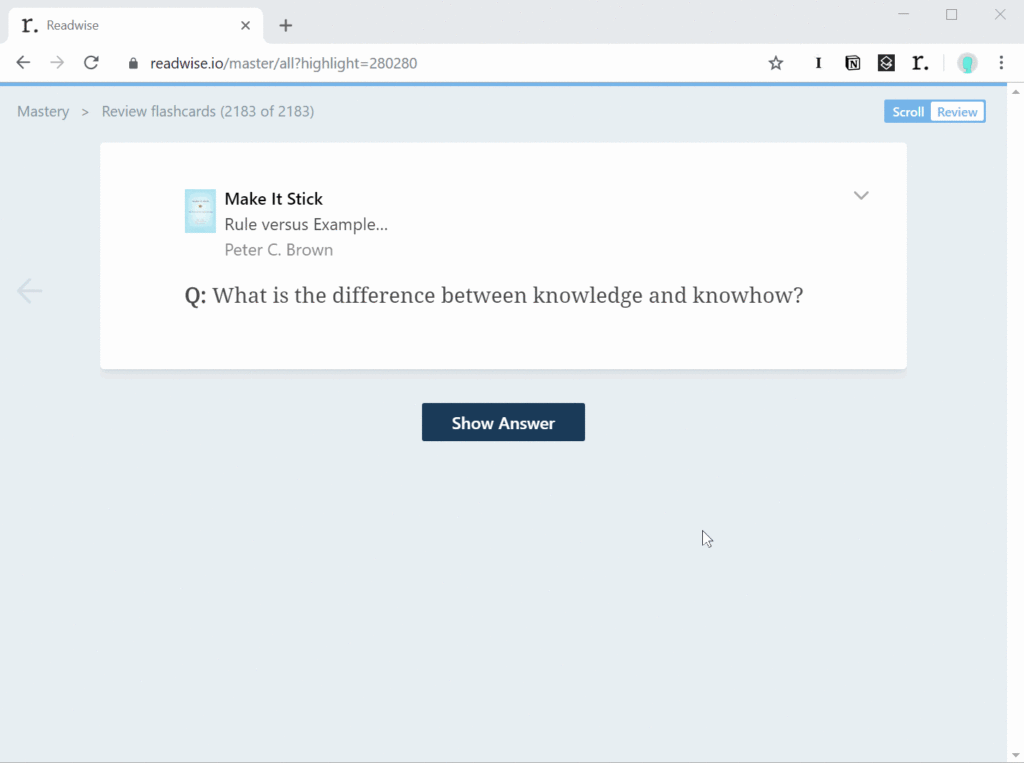Do you read lots of books, but struggle to remember any of the content after a while? Then you are going to enjoy this edition of our Tools for Thought series, where we meet with entrepreneurs on a mission to help us think better, be more creative, and more productive. In this edition, we talked to Daniel Doyon, the co-founder of Readwise, a powerful app that makes it easy to revisit and learn from your ebook and article highlights.
Readwise lets you import highlights from almost any reading source, review the part through a daily email or the app, and progressively recall more and grow your knowledge over time. It’s like reading with superpowers.
After many users asked them for more control over their reading experience, the team at Readwise has recently launched a new app called Reader, which allows people to do all of their reading in one place. It’s an all-in-one app to save what you want to read later, then actually read it, highlight and annotate the content, then search through everything you saved.
In this interview, we talked about the power of spaced repetition, how to judiciously select what to read about, the first principle of losing less before growing more, how repeatedly resurfacing hard problems you are working on can enhance creativity, the tension between institutional research and industrial research, the benefits of bootstrapping a business, how to incrementally go from “word vomit” to final essay, how they use “anti-goals” to stay laser focused on their long-term vision, and much more. Enjoy the read!
Hi Daniel, thank you so much for agreeing to this interview. Readwise is probably the most complete tool on the market to turn reading into actual learning. How would you describe it to someone who has never heard of it?
My pleasure! I’m delighted to participate. To be honest, we have always struggled to describe Readwise. People certainly understand the pain we are addressing: spending ten hours reading a book, only to promptly forget nearly everything in a week or two. But explaining our solution is difficult even to this day. The challenge is that there aren’t other mainstream tools we can reference as an analogy.
But here goes: Readwise is software that helps you get a higher return on time invested in reading by helping you gather all your annotations into one place, and then making it easy to consistently review those notes and highlights. That second part sounds mundane, but it’s where the magic is found.
Most productivity-oriented folks like us have a workflow for making highlights and taking notes while reading, but few of us have a system for consistently returning to those notes and highlights. Readwise closes this loop through a variety of measures. At its most basic, you will start receiving a daily email every morning containing a handful of your reading highlights. This eases you into a review habit. From there, you can take things to the next level using our fully featured web and mobile apps.
My guess is if your audience has heard of Readwise, it’s probably not for our resurfacing value proposition but for our syncing value proposition. Over the years, we have built over 30 integrations with reading apps upstream from us (Kindle, Apple Books, Google Play, Instapaper, Pocket, and even paper books through OCR and Twitter) and note-taking apps downstream from us (Evernote, Notion, Roam Research, Obsidian). Readwise makes it easy to continuously gather all these annotations into one place and then get them into your tool for thought of choice.
While these resurfacing and syncing value propositions enabled us to land a beachhead in the e-reading space, they are still relatively niche. We recently announced that we have begun building a much more ambitious piece of software: our own, fully integrated reading app, which we refer to as “Reader” for the time being.
Building your own, fully-integrated reading app sounds like a fairly ambitious endeavour… Why did you decide to go that route?
The simplest explanation is that this is what our users have been asking for, both directly and indirectly. For example, the chief complaints we receive these days are questions like: Why can’t I easily return to the context surrounding a specific highlight?
Why can’t I highlight and save images, tables, and rich text formatting, despite these being crucial to the reading experience? Why does it take so long for my highlights to sync? Why is it so hard to get highlights out of my PDFs?
Without control over the reading experience, we are not in a position to solve those problems and we are tired of telling our users: “Tough luck. Talk to [insert app name here].”
Bigger picture, however, this direction has always been our end game. When we started Readwise in 2017, we defined our mission as “to improve the practice of reading through software by an order of magnitude.” Even then we knew the only way to deliver on this promise would be to expand into the reading experience itself.
A full integrated reading experience does sound exciting! So, how does it work exactly?
Readwise is software-as-a-service rather than a social play, so we’re explicitly building for power users. Not mainstream consumers. To make a crude analogy, Reader is to Instapaper/Pocket as Superhuman is to Gmail. This is powerful software.
- Reader is cross-platform with continuously synced web apps, native iOS and Android apps, and browser extensions. Eventually, we will even create native desktop apps too.
- Reader is built on a local-first architecture so it’s blazingly fast with full-text search of your entire library. On desktop, you can do everything with keyboard shortcuts as if you were in Microsoft Excel or Superhuman. It’s delightful.
- Reader handles all your documents from web articles like Instapaper and Pocket, to newsletters, PDFs, ebooks, and more. Up until Reader, our users have been stitching together somewhere between 2 to 6 apps to cover their entire reading workflow. This is a huge hassle that we’re solving.
- Reader embeds opinionated workflows enabling you to overcome content overload. Our users tend to save vastly more documents than they have time to read, which creates a constant feeling of overwhelm or falling behind. We can’t create more time, but we can at least put you in control.
There is much more to Reader than that, but hopefully this gives you a rough idea of our product philosophy.
Integrating RSS, PDFs, newsletters, web highlighting and more into one cross-platform app sounds like a massive challenge. How did you go about it?
It is a massive challenge and there’s still much left for us to build — which is why Reader is currently in private beta rather than publicly released — but we’re moving swiftly. In fact, our shipping velocity is actually accelerating over time, which is the exact opposite of how almost all complex software systems get made.
Normally things slow down as tech debt slowly accumulates and ultimately comes due. In the case of Reader, we have been working on Readwise for nearly half a decade now, we have a lot of past experience and domain expertise helping us to avoid pitfalls and deadends.
Like I said, we have been contemplating our own reading app for years, but we knew it didn’t make sense to start until we discovered what my cofounder Tristan calls the right “core abstractions.”
We needed a conceptual breakthrough, kind of like how the “block” abstraction enabled the massive success of Notion and Roam Research in contrast to earlier generations of note-taking apps like Evernote. You might think you could just cargo cult the concept of a block to a modern reading tool, but reading and writing are just too different. We needed something new.
At the beginning of 2021, we finally discovered the core abstraction we had been looking for, so it was time to get to work. The pieces have been falling into place ever since.
The other big thing is that Readwise finally grew beyond just me and Tristan. We have been so fortunate to become a part of a talented team of engineers, designers, and support folks — almost all of whom we met through our user base!
Readwise has evolved so much over the years. How different is it from the original idea?
The origin of Readwise is a classic “scratching your own itch” story. I was on a yearlong sabbatical in 2015/2016, traveling the world with my trusty Kindle device and reading one or two challenging books per week. About halfway into that trip, I became frustrated that I could hardly recall the title or author of a book I had read two months ago, nevertheless the key takeaways.
This pain struck me at the exact moment that I was overcoming the learning curve of a popular but user-unfriendly flashcard application, which I’m guessing many of your readers have used before, called Anki.
I wondered to myself: What would happen if I wrote a script to scrape all these Kindle highlights I’ve been taking, converted them into Anki flashcards, and then reviewed those for 5 to 10 minutes each morning?
Well, I did that and in short order confirmed my initial hypothesis that a brief review each morning would crystallize my retention of the book I had recently read. What blew my mind, however, was that over time I started to notice unexpected second order benefits. The Eureka moment is thoroughly described here.
Keep in mind that there were no commercial motives here: this Anki practice was purely hobbyist, lifehacker self-experimentation. That said, the profound second order benefits caused me to become increasingly fascinated by the potential of what my co-founder Tristan and I now call “reading tech”.
Software is eating the world. Software has clearly “eaten” the practice of writing. Yet the practice of reading is still mostly analog. You would never write a book or blog post on a typewriter instead of a word processor, meanwhile only a small fraction of people read nonfiction ebooks over paper books.
Are books somehow perfected in their current form? Is there no opportunity to improve reading using software? We think not.
Tristan arrived at this insight independently and from a different direction. Whereas my system was focused on the problem of retention (the pain of forgetting too much of what you read), Tristan was focused on the problem of selection. Even if you read a book a week for your entire life, you will only read 3,000 or so books. Meanwhile, millions of books are published per year. One needs to be somewhat judicious with your reading selections.
We bonded over this mutual interest in reading tech and decided to collaborate on an MVP called Rekindled which has since evolved into Readwise as you know it today.
To answer your question about how different Readwise is from the original idea, Readwise 1.0 — as we call it now — is actually eerily similar to my lifehacker prototype from 2016 except way smoother and much more user friendly, of course.
Reader, on the other hand, has only taken form in the past year or so. We knew from the beginning that we wanted to build a reading app, but we didn’t have a clear vision of what that would look like until we got deeper into the idea maze.
Another great feature you recently launched is Themed Reviews. Are there particular use cases you think Themed Reviews are particularly suited for?
The most obvious use case of Themed Reviews is to make a review based around, well, a theme. For example, because Readwise is my business, I have a Themed Review around highlights related to Readwise that I review each morning. It’s incredibly helpful when trying to level up or working on hard problems with elusive solutions.
We have noticed that once our users grow comfortable with Themed Reviews, they begin to get a little more creative. One common use case is workflow-oriented: an Inbox. If you are familiar with GTD and its progeny, you’re often advised to create an Inbox — perhaps physical, perhaps in your note-taking app — where you put new items to be processed as part of a workflow.
That sounds great in theory, but in practice, most people fall behind after a week. An Inbox Themed Review, on the other hand, hijacks a daily habit that our users have built around their daily review (we have thousands of users who have maintained the daily review habit without breaking the chain for over a year). You could think of it as a lightweight GTD inbox.
The magic of Readwise lies in the way it encourages recall, rather than just storing highlights to be quickly forgotten. How does that work exactly?
One framework we have found especially helpful to structure such product discussions is to separate reading into three components: before, during, and after you read.
If we can build software that helps you be twice as effective in each of these stages — choose twice as efficiently before you read, comprehend twice as deeply while you read, and retain twice as much after you read — the compounded effect will be the Thielian 10x improvement we are shooting for.
We began Readwise by focusing on what happens after you read. To us, this means addressing the problem of retention. Starting with this problem, we believed, would make the greatest immediate impact on reading for two reasons.
First, from a practical perspective, it’s a common pain point that you quickly forget most of what you read. Meanwhile, there were no other products offering a purpose-built solution to retention. Second, from a theoretical perspective, the best way to start growing more in any domain is to first lose less. We see this first principle everywhere:
- In a subscription business, you are better off reducing churn before increasing sign-ups.
- In personal finance, you are better off spending less before earning more.
- In investing, you are better off stopping losses before seeking gains.
- If you want to fill a leaky bucket, you first need to stop the leak. If you want to get more out of reading, you first need to forget less.
So how do we encourage recall? We leverage concepts in learning known as spaced repetition and active recall.
Spaced repetition is a technique for spacing out of reviews of previously learned material according to an algorithm designed to optimize your limited time for review. Each time you review a piece of information, you supply feedback to the spaced repetition algorithm which estimates the optimal time to show you that information again.
Without getting too technical, if you truly understand something, you don’t need to be reminded of it that often whereas if you constantly struggle with something, you need to be reminded of it all the time until it’s integrated. Spaced repetition is the literal opposite of cramming which, we don’t have to tell you, is a great way of passing a test but a terrible way of truly learning something.
Importantly, you don’t need to know and/or appreciate these esoteric concepts to immediately begin using Readwise. In contrast to virtually every other flashcard application out there (and Readwise is not a flashcard app, for the record), the bar is low for you to immediately get value out of the daily review practice. Just import some of your Kindle highlights or add some paper books you’ve read. The software will hold your hand up and walk you up the learning curve from there.
I’ll be honest with you: spaced repetition is the most misunderstood aspect of Readwise to this day. When people hear that term, they immediately imagine laboriously studying, say, flashcards with French vocabulary. Sure, spaced repetition is great for this kind of learning, but what we have accidentally discovered through practice is that spaced repetition has much, much broader applications than rote memorization.
For example, spaced repetition can also be leveraged to enhance creativity by repeatedly resurfacing a hard problem you’re working on — from different angles and in different contexts. I’ve even begun to write essays using spaced repetition!
I need to be careful here as our claims regarding the novel applications of spaced repetition are not yet backed up by scientific evidence. Our challenge is that we’re too busy building to also spend our days conducting research and writing papers explaining how spaced repetition generalizes beyond helping people memorize random sequences of letters (this is in reference to the Ebbinghaus forgetting curve on which the study of spaced repetition is founded). Unfortunately, this has caused some illuminati in your domain such as Andy Matuschak to claim we’re charlatans.
Personally, I think this is a classic example of what Nassim Taleb calls the Lecturing-Birds-How-to-Fly Effect, in which academics believe that institutional science enables practitioners like us to build technology when it’s usually the other way around. But whatever. We are hackers, not researchers. Caveat emptor.
You have your critics, but overall, the positive feedback I read about Readwise is wild. How did you foster such a supportive community around your product, especially in the early days?
This is an interesting question to us right now because we are actively thinking about the implications of “community” but we have no idea how we fostered ours to date.
A couple hypotheses: first, Tristan and I very much do things that don’t scale such as personally responding to each and every email ourselves for the first three years of Readwise’s existence. Second, we listen closely to our customers for their pains and try to develop solutions, even if our solution is not always what they thought they wanted. Third, we are bootstrapped meaning we can be successful even if we fail to deliver the next Google.
This means we can stay focused on our niche of productivity-oriented power users — which is not a venture scale market, for the record — without having to dilute our appeal by pretending to be a social network or something. I think those factors have helped us forge a trust-based relationship with our community.
And how do you personally use Readwise in your daily life?
Including the prototype that became Rekindled that became Readwise, I have been daily reviewing my reading highlights for nearly seven years now. Eat your own dog food, as they say.
At the moment, my favorite emergent use case of Readwise is the writing workflow I mentioned earlier. Even though I love writing, I have a really hard time because I can’t separate my drafting personality from my editing personality. The editor gets in the way of the drafter. My solution here is a special Themed Review process.
When I have a topic to write about, I quickly jot down as much as I can in my note-taking app without any filter whatsoever. If I struggle to articulate a point, I just write some shorthand and keep going. This isn’t even a first draft; it’s more like a word vomit.
I then atomize these inchoate thoughts into individual “highlights” inside a custom book in Readwise with a working title for the ultimate essay. Once made, I set up a Themed Review drawing from this “book” plus a custom tag for the essay that I use to include relevant highlights and tweets from other sources.
I then spend a few weeks reviewing five of these passages per morning. I’m not just reading the passages: I actively edit them for clarity of language and thought. Once I have done this for a while, I finally export the polished passages back into my note-taking app where I reorder things into a logical sequence and identify any logical gaps. I add in the connectives, edit the whole document one last time, and hit publish.
I wrote a 5,000 word essay announcing Reader using this method and the last step of finishing the document took me only a few hours. I wrote a 2,000 word essay announcing Themed Reviews and the last writing step took me only 40 minutes!
One cool thing about this is you end up with an essay that is disproportionately “highlightable” because nearly all the component paragraphs were written standalone. This forces you to write in a particularly clear and contextual style.
That’s an amazing use case. Many tools for thought tend to do too many things and become bloated as a result. What’s your long-term vision for Readwise?
Bloat is especially common when you’re building tools for power users who have a variety of very esoteric workflows — and who are not shy about sharing those workflows! To avoid bloat, we always try to keep some “anti-goals” front and center (borrowed from Joel Spolsky).
In the case of Reader, which is definitely the long-term vision for Readwise, we have drawn some hard lines in the sand on what we are not going to build:
We are not building another note-taking app. There is incredible innovation taking place in this space already and we have little to add but for ensuring your notes and highlights cleanly interface with your tool of choice. (We are using the term “note-taking app” here in the colloquial sense. We acknowledge these apps encompass much more than just note-taking.) Meanwhile, our passion from the start has been reading, and our frustration continues to be the lack of software innovation in this phase of the knowledge acquisition loop.
We are not attempting to make reading social or enable an internet-scale annotation layer. To be clear, we can definitely appreciate the allure of this dream. As avid readers ourselves, there is nothing more we would love more than to discuss what we are reading with like-minded folks. As entrepreneurs, there is no business that would be more lucrative than pulling off a new social network. But despite the constant cries for something like this on Twitter, we think it’s a classic case of worse is better. You couldn’t invent Figma before Sketch and Illustrator nailed the single-player vector-based experience. So it is with reading software. Or so our theory goes.
Maybe we’ll be proven wrong. Maybe someone will have an insight that drives a wedge into the network effects surrounding Twitter, Reddit, Slack, Discord, et al. But that group will not be us. As toolmakers, we see so much low hanging fruit in single-player mode that we can hardly fathom multiplayer.
We are NOT trying to apply the wisdom of the crowds, artificial intelligence, or mechanical turks to replace everything you read with derivatives. We do believe summaries, auto-categorizations, and social chatter can augment your reading experience. But we don’t believe these should be the product itself or serve as a substitute for reading the primary source. We want to help you go deep into what matters. Not skim along the surface.
The concept of anti-goals is amazing, thank you so much for sharing! Where can people learn more about Readwise?
Our current landing page at readwise.io is where you can sign up for our existing product, but it’s outdated and doesn’t yet reference Reader. If you want to learn more about Reader, we made a special page here. That includes a link to the essay I mentioned prior explaining the philosophy behind Reader.
We are active on Twitter. You can follow me @deadly_onion (anagram of my name), my cofounder Tristan @homsiT, or our company @readwiseio.
Finally, we are ramping up a Readwise community Discord server. Right now it’s private and mainly serves the private beta testers of Reader, but ultimately we’ll open it up to the public.




